Poetry is a powerfully expressive form of writing. At least it should be. Unfortunately, it can also be a particularly painful genre because, apparently, it is a fiendishly difficult thing to describe, let alone do well.
Look through any compilation of quotes about poetry from famous writers and you will notice that even they struggle to encapsulate poetry with clarity and consistency.
Given this inability to express what it is, you would be forgiven for thinking that poetry is a particularly esoteric art form and it would be sheer folly to even try to get children to attempt it.
Yet attempt it we must, according to the National Curriculum. So here are some tips, and KS1 and KS2 resources, to help you teach poetry techniques with confidence and, hopefully, minimal pain...
Harness enthusiasm
Despite that rather pessimistic introduction, poetry is often a genre that pupils enjoy experimenting with. Maybe it’s the emphasis on quality rather than quantity that appeals to some.
It means they can focus on word choices and play with figurative language and meaning. This is opposed to getting hung up on technical aspects of writing or worrying about how much they are expected to produce.
Harness that enthusiasm and encourage them to think carefully about each and every word choice. You might be pleasantly surprised.
Poetic techniques examples – immersed in verse
Before you ask pupils to put pen to paper, make sure you have given them a solid introduction to the style of poetry you will be asking them to produce.
Choose your examples well. Take time to study the forms, features and poetic techniques you would like them to imitate. This might be a narrative poem or something with a basic ABAB rhyme scheme.
Remember, even the most experienced and ardent poetry lovers argue and agonise over famous poets and what each line was supposed to convey. Therefore, don’t be put off if you don’t always ‘get it’.
Even so, this might be a great opportunity to open the class discussion and allow pupils to extract their own meaning from each piece.
For a more structured approach, poetry comprehension exercises are invaluable. You could use past SAT papers, which occasionally feature poetry. However, you may want to keep those for more formal assessment.
In which case, for example, try our classic poetry comprehension pack which focus on extracts from Robert Louis Stevenson.
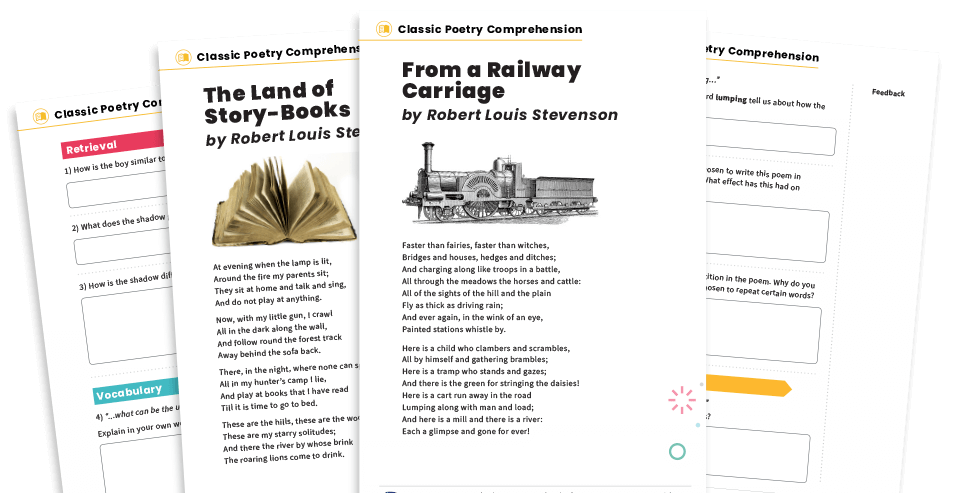 Classic poetry comprehension worksheets
Classic poetry comprehension worksheetsDifferent styles of poetry
List poems: Encourage creativity in KS1 using simple structures, rich vocabulary and model examples to create playful, descriptive verse on any theme.
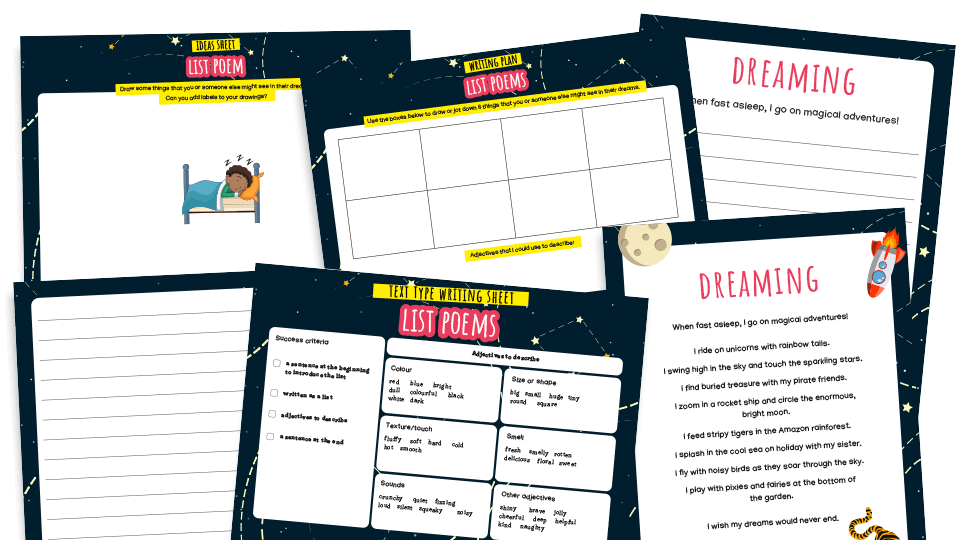 KS1 list poems resource pack
KS1 list poems resource packRhyming couplets: This pack helps children explore, analyse and create rhyming couplet poems through five structured challenges.
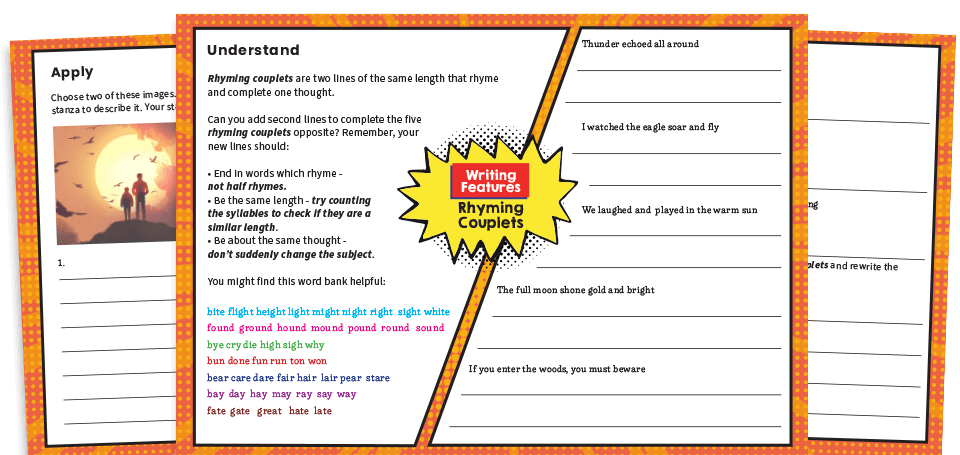 KS2 rhyming couplets worksheets
KS2 rhyming couplets worksheetsHaikus: Introduces this form through nature-themed examples and WAGOLLs.
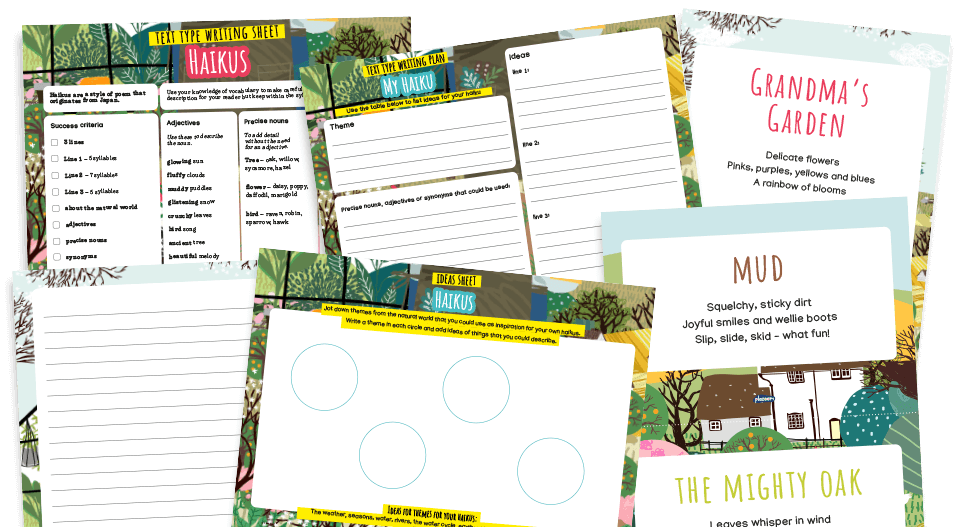 KS2 haikus writing planners and model texts
KS2 haikus writing planners and model textsSenses poems: KS1 learners move from analysing WAGOLL model texts to creating their own poems using the five senses. This is supported by visual prompts, planning sheets and writing scaffolds.
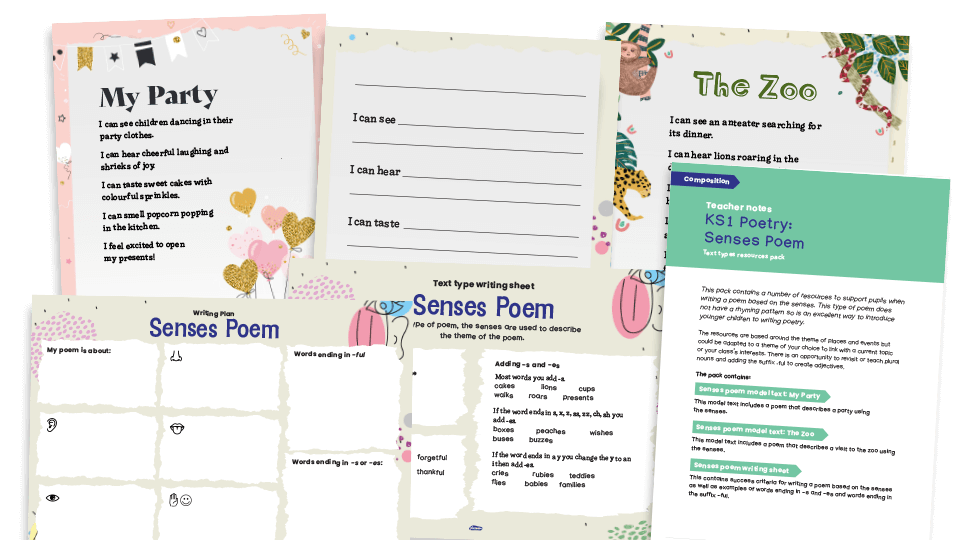 KS1 senses poem resource pack
KS1 senses poem resource packCinquains: Provides KS2 writers with model texts, word banks and structured worksheets to understand, plan and write five-line poems.
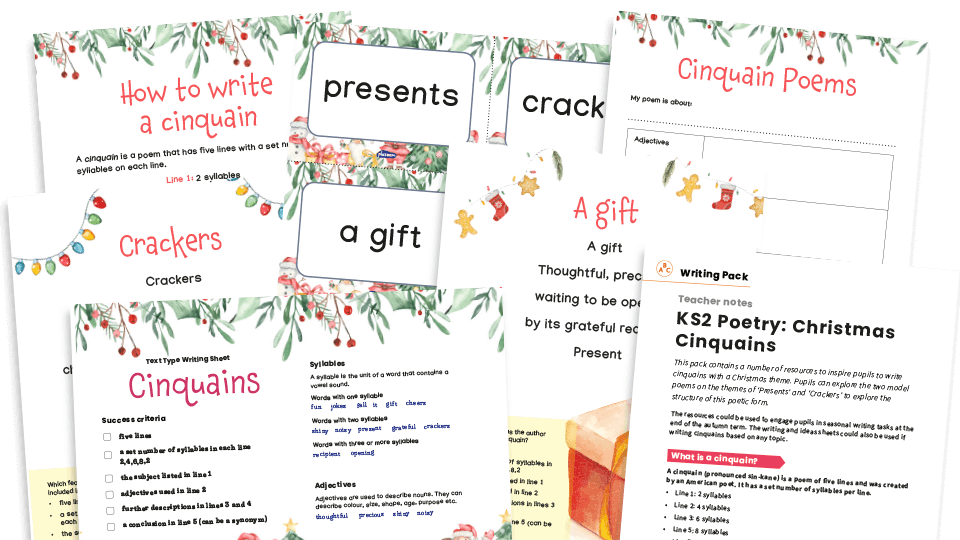 KS2 Christmas cinquains writing planners and model texts
KS2 Christmas cinquains writing planners and model textsNarrative poetry: Guides students to examine a model poem retelling Goldilocks. They will then plan and compose their own story-based poems using structured sheets and idea cards.
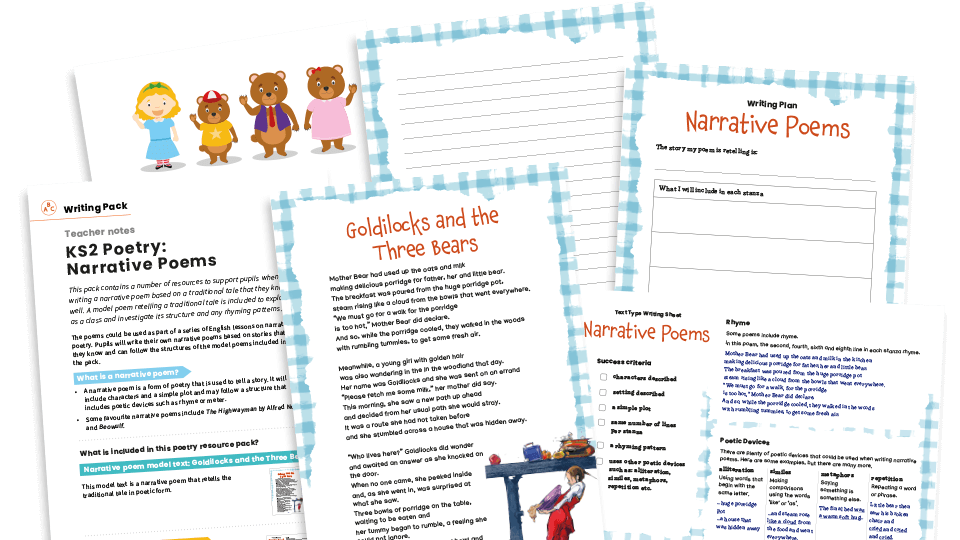 KS2 narrative poem based on Goldilocks and the Three Bears
KS2 narrative poem based on Goldilocks and the Three BearsLimericks: Offers a framework for KS2 learners to read, analyse, plan and write humorous five-line limericks using WAGOLL examples and structured planning sheets.
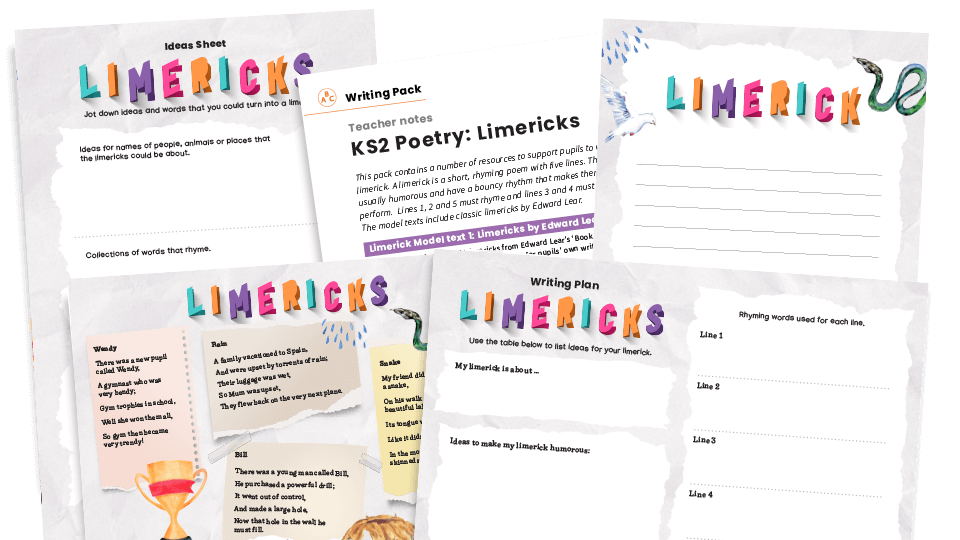 KS2 limericks writing planners and model texts
KS2 limericks writing planners and model texts
Different poetic techniques – tricks of the trade
Apart from giving your pupils the chance to understand and express their own appreciation of poetry, it is also your job to introduce them to poetic techniques that they could use in their own efforts.
There is no shortage of these. Plan to focus on one or two of them at a time rather than trying to cram them all into one composition.
And do remember, strict rhyme schemes can prove to be a limitation on creativity for young poets. Also, it is important to pitch your poetry genres at suitable age groups.
Common poetic techniques
- Metaphor – compares one thing to another by saying it is that thing.
- Simile – compares one thing to another using like or as.
- Allegory – a story or poem with a hidden meaning, often moral or political.
- Allusion – a reference to a well-known person, place, event or text.
- Imagery – descriptive language that appeals to the senses.
- Onomatopoeia – words that imitate the sound they describe.
- Rhetoric – persuasive language used to influence or convince.
- Repetition – repeating words or phrases for emphasis or effect.
- Assonance – repetition of vowel sounds within nearby words.
- Consonance – repetition of consonant sounds within nearby words.
Different poetic techniques for young poets
Pupils who are just learning to write cannot be expected to create profound and technically proficient poems written in iambic pentameter or iambic trimeter.
Nor do they need to know the difference between a stressed syllable and an unstressed syllable, or be familiar with the full canon of 19th-century poetry.
However, there are forms that can help them to develop their nascent writing skills and investigate phonically helpful ideas such as rhyme or repetition.
They can also experiment with simple forms of poetry that help them to view writing as a way to express themselves, especially when used as part of a lesson about life issues.
For example, we have a FREE resource pack designed to help KS1 children explore the concept of friendship. This culminates in them producing an acrostic poem of their own.
 KS1 ‘Friends’ acrostic poems resource pack
KS1 ‘Friends’ acrostic poems resource packFigurative language
From the end of KS1, children begin to experiment with aspects of figurative language such as similes. By the beginning of KS2 they will be moving on to metaphors.
Trying to get them to include them in narrative writing can be a bit of a stretch, especially considering all the other things they are supposed to remember.
Using a poetry unit to help them focus on these techniques could benefit their writing across the board. The below resource for Year 3combines an engaging model text with structured activities that help pupils explore figurative language, poetic structure and vocabulary. They'll then apply these techniques in their own writing.
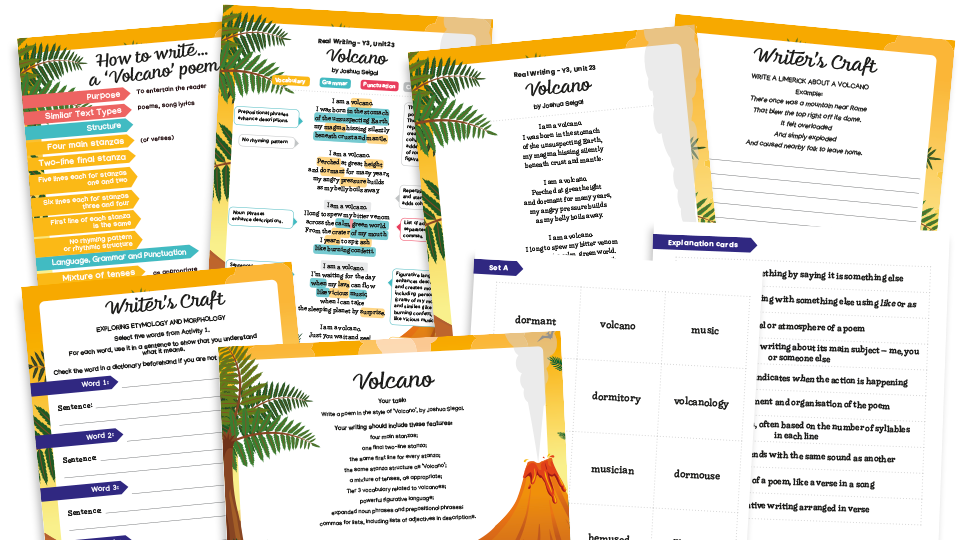 Year 3 model text resource pack
Year 3 model text resource packThis KS2 metaphors poetry pack teaches pupils to create vivid imagery using metaphors, prepositions and expanded noun phrases through model poems, planning sheets, writing scaffolds and guided practice.
 KS2 metaphor poems
KS2 metaphor poemsRemember to examine good illustrations of figurative language in published works to make sure your class understands how they work and why they are effective.
For a permanent visual reminder, why not display our posters, which give examples of figurative language around an eye-catching image.
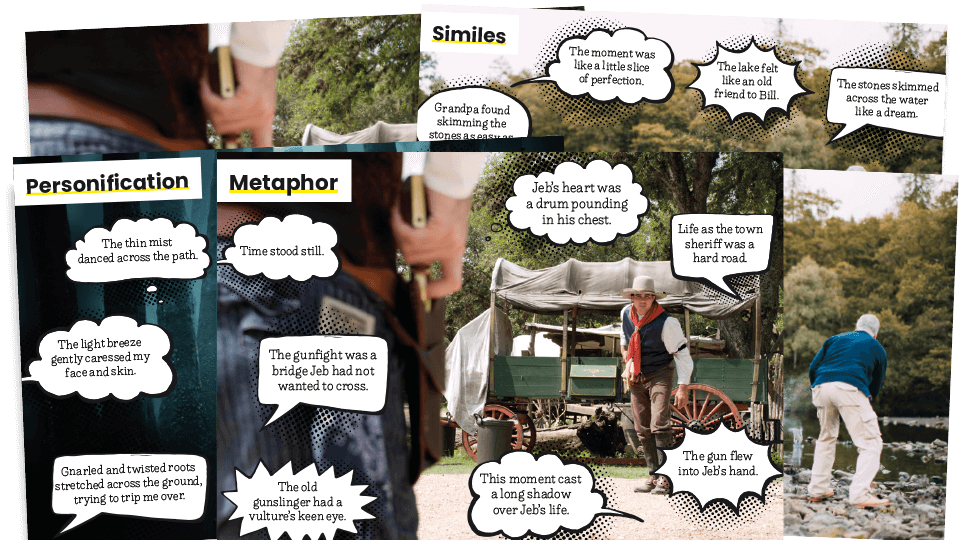 KS2 metaphors, similes and personification writing posters
KS2 metaphors, similes and personification writing postersUsing personification as a literary device
Personification is a form of figurative language that deserves its own section here because it is such a popular feature of poetry.
There is nothing that brings ideas to life more than actually giving them life in the form of human actions or traits.
If you get the chance, take your class outside to look at the world around them. Discuss opportunities for personification. Houses huddling together; leaves dancing on the breeze; clouds racing each other across the sky.
Once they start letting their imaginations run free, you’ll be amazed at what they come up with.
To consolidate these ideas, pin up our personification poster once you’re back in the classroom. Alternatively, give children our personification challenge mat to practise with.
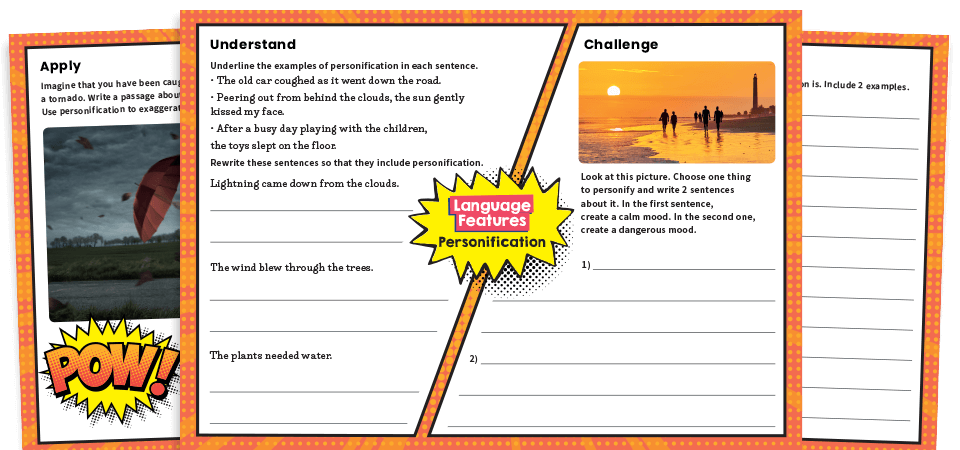 KS2 personification challenge mat worksheets
KS2 personification challenge mat worksheetsRhyme, rhythm and sounds
Allow pupils scope to play with word sounds in ways other than rhyming. Alliteration is something most will be able to do without much problem (it can be tiresome if overused, however).
Assonance is when words with the same vowel sound are used in close proximity, such as the igh sound in time flies while I’m writing. To explore this further, try our KS2 challenge mat on assonance.
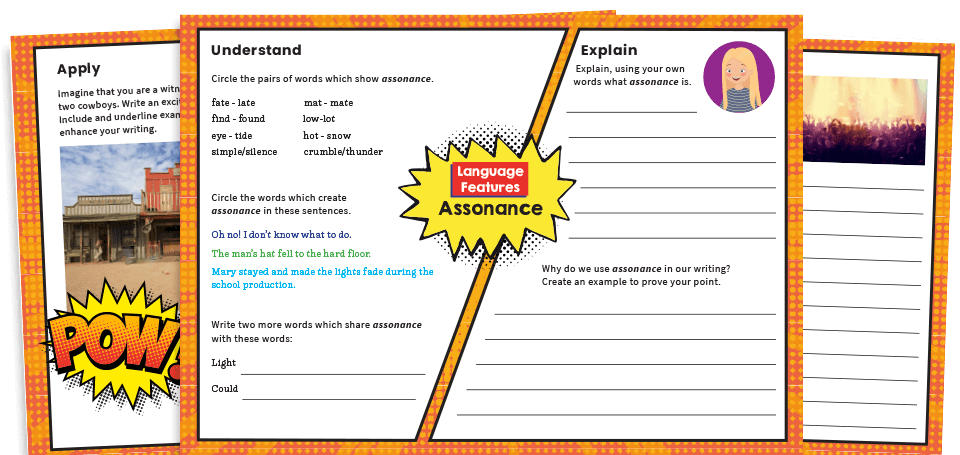 KS2 assonance worksheet
KS2 assonance worksheetPoetic techniques – word choice and thought sculpting
Imaginative word choices are a critical part of poetry. Expanded noun phrases are a good way of creating concise descriptions. However, you can take it even further by letting your pupils experiment with kenning.
Rooted in old Norse and Anglo-Saxon epic poetry such as Beowulf, kenning involves creating figurative noun-phrases to replace familiar ideas.
For example, the whale-road might be the sea and a wave-splitter might be a boat. Let your class have a go – you might be pleasantly surprised.
This resource introduces KS2 pupils to the fun, riddle-like structure of kennings, giving them models, planning tools and writing support to create their own descriptive poems linked to any topic. There's also a KS1 kennings pack.
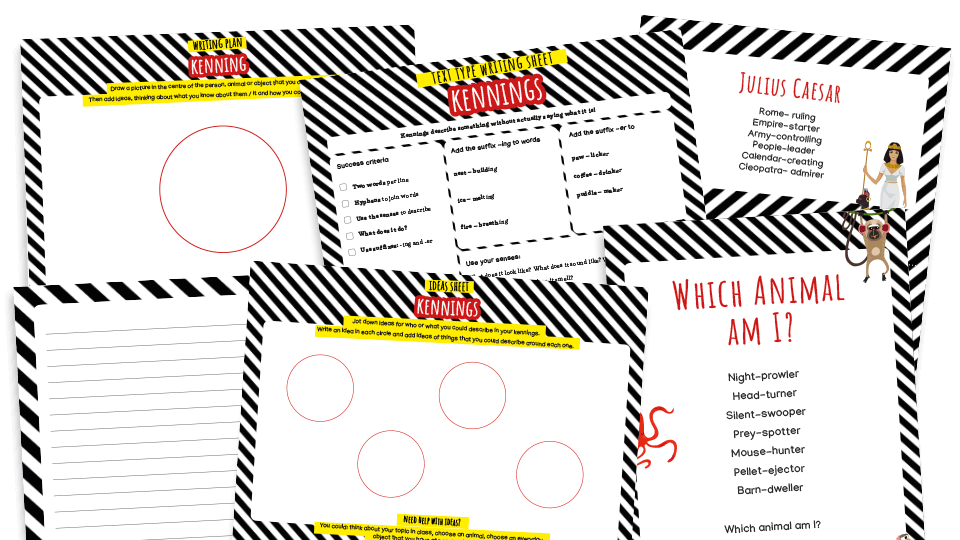 KS2 kenning poem resource pack
KS2 kenning poem resource pack
Now that you have a range of techniques with which to arm them, you can feel more positive about letting your pupils have a go. Don’t worry, it could be verse...
Sue Drury qualified as a primary teacher in 1999. Teaching pupils from Year 1 to Year 8, she has held a variety of positions including maths and English subject leader, year leader, and assistant headteacher. Sue has mentored students and NQTs, offering guidance and advice using her years of experience. She created many of Plazoom's literacy resources.